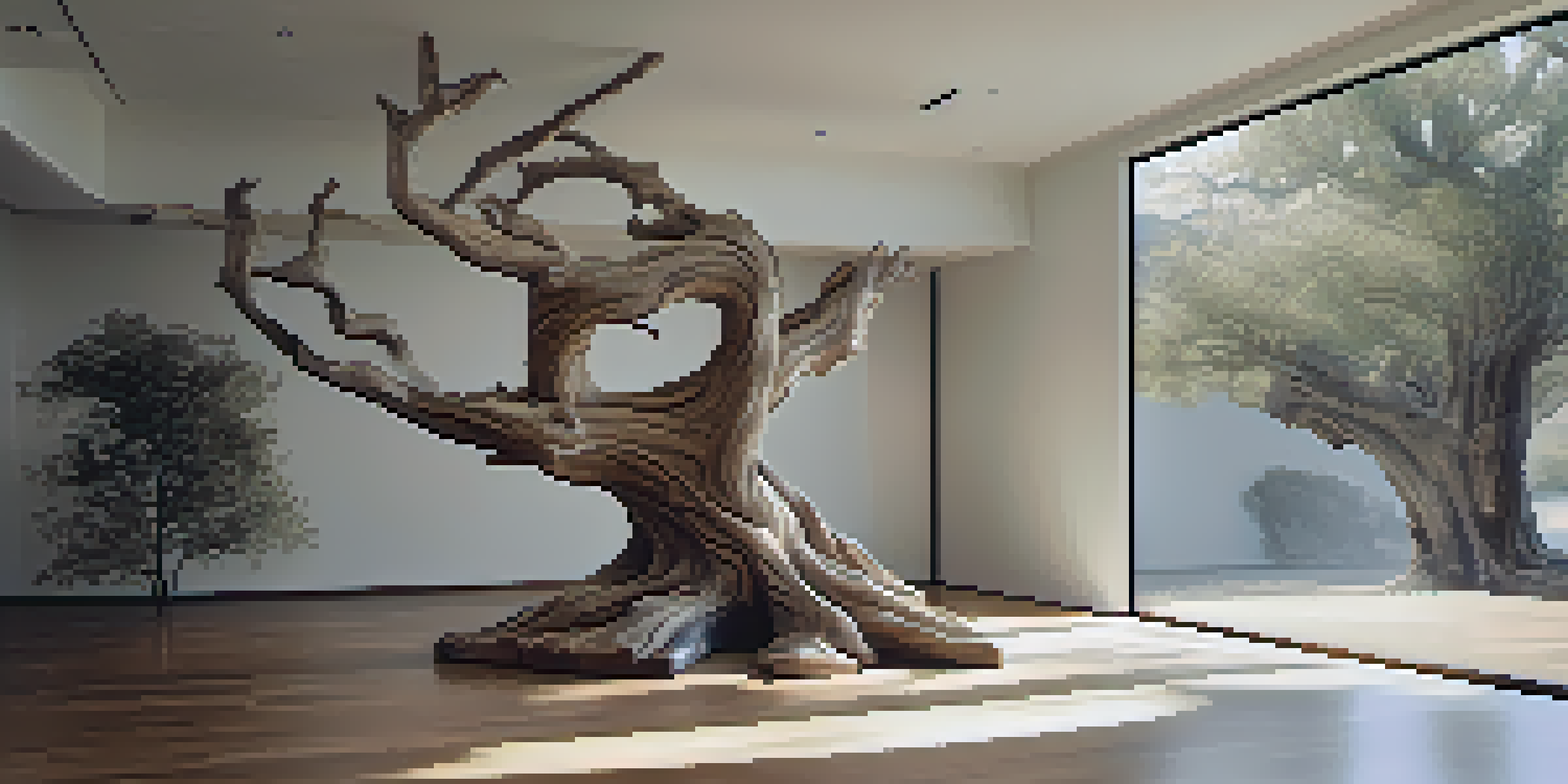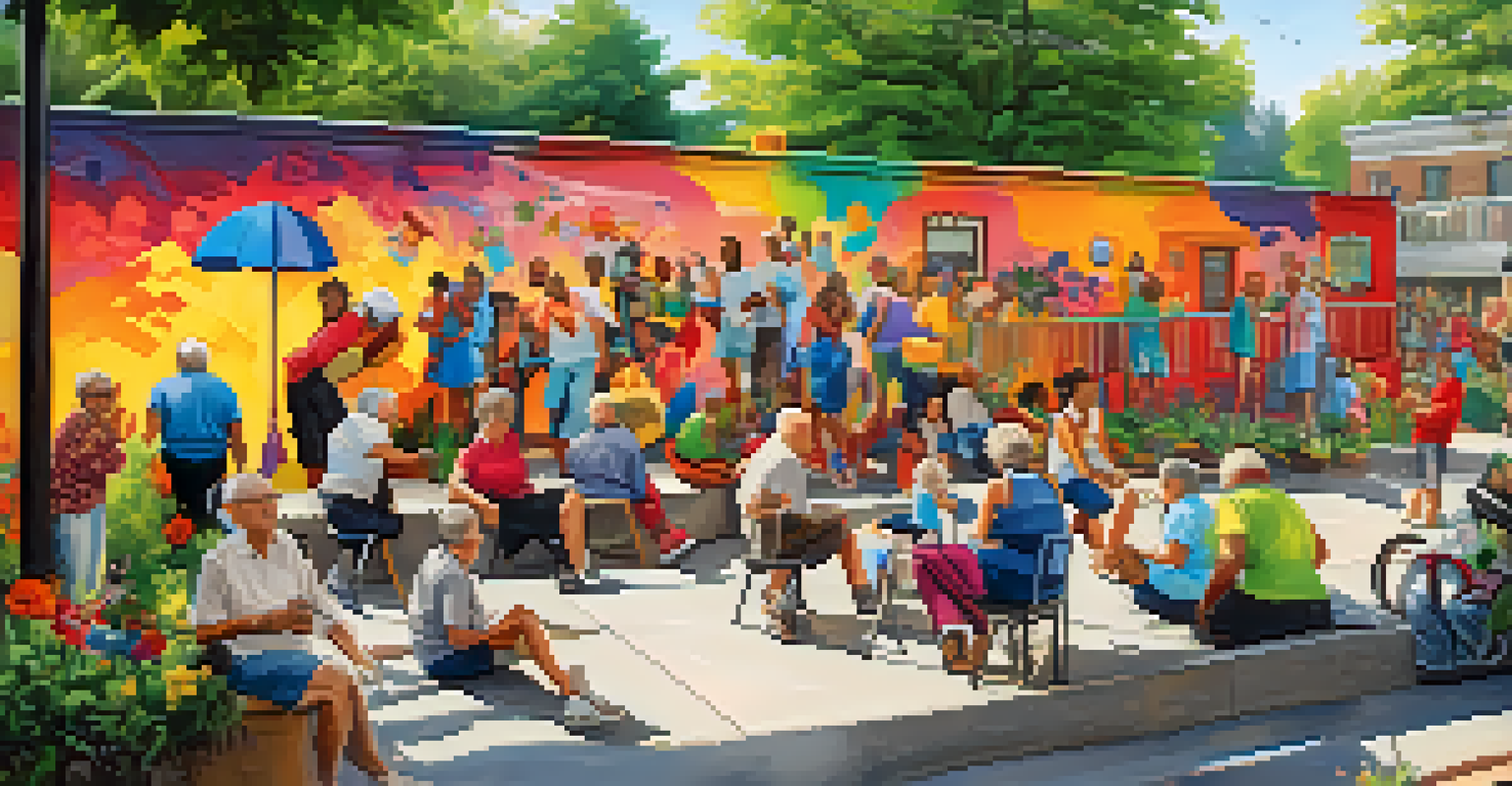Aging Bodies: The Human Form in Contemporary Art

The Role of Aging in Contemporary Art Narratives
Contemporary art often serves as a mirror reflecting societal values, including our perceptions of aging. Artists utilize their work to challenge the traditional narratives surrounding the aging body, portraying it not as a decline but as a unique and rich experience. This shift allows viewers to engage with the complexities of aging, encouraging a more profound understanding of life stages.
Aging is not lost youth but a new stage of opportunity and strength.
For instance, artists like Cindy Sherman have explored the aging process through photography, presenting themselves in various stages of life. By doing so, they invite us to confront the often-ignored realities of aging, pushing back against the societal tendency to idealize youth. These artistic expressions help to normalize conversations about age and the human experience.
Ultimately, the role of aging in contemporary art encourages us to rethink our relationship with time and identity. As we embrace the narratives artists create, we gain a deeper appreciation for the beauty and wisdom that come with age, fostering a more inclusive dialogue about what it means to grow older.
Physicality and Vulnerability in Aging Art
The aging body is often depicted with a focus on its physicality and vulnerability, reminding us of the fragility of life. Artists frequently use materials and techniques that emphasize texture and form, creating pieces that resonate with the viewer on a sensory level. This tactile approach can evoke empathy, inviting us to reflect on our own bodies and experiences.

Take, for example, the sculptures of Louise Bourgeois, who often portrayed aging figures with raw emotion and honesty. Her works highlight the imperfections of the body, serving as powerful reminders of the shared human condition. By embracing vulnerability, these artworks create a space for connection and understanding among audiences.
Aging Reimagined in Contemporary Art
Contemporary artists challenge traditional views of aging by portraying it as a rich, complex experience rather than a decline.
In this way, the physicality of aging in art becomes a celebration rather than a lamentation. It encourages us to embrace our imperfections and recognize that vulnerability is part of the human experience, making the conversation around aging more relatable and less intimidating.
Challenging Stereotypes Through Artistic Expression
Contemporary art plays a crucial role in dismantling stereotypes associated with aging. Many artists intentionally depict older individuals in ways that challenge societal norms, presenting them as vibrant, active, and engaged in contemporary life. This shift helps to combat the pervasive stereotypes that often portray older adults as frail or disengaged.
The beauty of a woman is not in the clothes she wears, the figure that she carries, or the way she combs her hair. The beauty of a woman is seen in her eyes, because that is the doorway to her heart—the place where love resides.
An example is the work of photographer Arielle Bobb-Willis, who captures older subjects in lively, dynamic poses, showcasing their strength and individuality. By shifting the narrative, these artists not only empower older individuals but also invite society to reconsider its assumptions about aging. This artistic expression can lead to a broader cultural change by reframing how we view age.
Through challenging stereotypes, contemporary art fosters a more inclusive representation of aging, allowing for a richer dialogue about the experiences and contributions of older adults. This shift is vital in promoting acceptance and appreciation for the diversity within the aging population.
The Intersection of Aging and Identity in Art
Aging is intricately linked to identity, and contemporary artists explore this relationship in compelling ways. Many works delve into how age influences not only self-perception but also how others perceive us. This exploration often leads to poignant reflections on the intersectionality of age with other aspects of identity, such as gender, race, and sexuality.
For instance, artist Faith Ringgold's quilts often incorporate narratives that highlight the complexities of aging within the framework of race and gender. By weaving together these themes, artists like Ringgold create multifaceted portrayals that resonate with a broad audience, inviting deeper contemplation on the interplay of identity and aging.
Art as Advocacy for Aging Voices
Many artists use their work to advocate for older adults, combating ageism and promoting a more equitable representation in society.
The discussion of aging and identity in art encourages viewers to examine their own experiences and biases. It fosters a greater understanding of how age shapes our lives and identities, reinforcing the idea that aging is a universal experience that connects us all.
Aging Bodies in Performance Art: A Moving Perspective
Performance art provides a dynamic platform for exploring the aging body, as it emphasizes movement and the lived experience. Artists often use their own bodies as a canvas to express the realities of aging, creating powerful and thought-provoking performances that engage the audience on multiple levels. This medium allows for a raw and authentic exploration of the aging experience.
Take Marina Abramović, for example, who has used her body in various performances to confront themes of endurance and vulnerability. Her work often emphasizes the physical limitations that come with age, while also highlighting the strength and resilience found in those limitations. This ability to convey complex emotions through movement challenges viewers to reflect on their perceptions of aging.
Through performance art, the aging body becomes a site of exploration and dialogue. It encourages us to appreciate the stories our bodies tell and the experiences they embody, highlighting the beauty and complexity of aging in a visceral and immediate way.
Art as a Tool for Advocacy in Aging Representation
Art has the power to advocate for change, particularly in how aging individuals are represented in society. Many contemporary artists use their platforms to raise awareness about ageism and advocate for the rights of older adults. This advocacy often takes the form of community-engaged projects that empower older individuals to share their stories and experiences.
For instance, the 'Elder Artists' project empowers older artists to create and showcase their work, fostering a sense of community and belonging. By amplifying the voices of older individuals, these initiatives challenge ageist narratives and promote a more equitable representation of aging in the art world and beyond. This advocacy is crucial in shifting societal perceptions of aging.
Identity Intersects with Aging in Art
The relationship between aging and identity is explored in art, revealing how age influences self-perception and societal views.
Through art, we can cultivate a greater understanding of the challenges faced by older adults while celebrating their contributions. This powerful intersection of art and advocacy paves the way for a more inclusive society where aging is embraced rather than marginalized.
The Future of Aging Bodies in Contemporary Art
As society evolves, so too does the representation of aging bodies in contemporary art. Emerging artists are increasingly exploring the multifaceted nature of aging, pushing boundaries and challenging existing narratives. This ongoing evolution reflects changing societal attitudes towards aging, as well as advancements in technology and media.
For instance, the rise of digital art has opened new avenues for exploring the aging body, allowing artists to create virtual representations that transcend traditional limitations. These innovative approaches not only engage younger audiences but also create a dialogue about the future of aging in a rapidly changing world. The conversation is becoming more dynamic and inclusive.

Looking ahead, it is clear that the representation of aging bodies in contemporary art will continue to evolve, reflecting broader societal shifts. This ongoing dialogue will be vital in shaping our understanding of aging, fostering a culture that values and respects the experiences of older individuals.